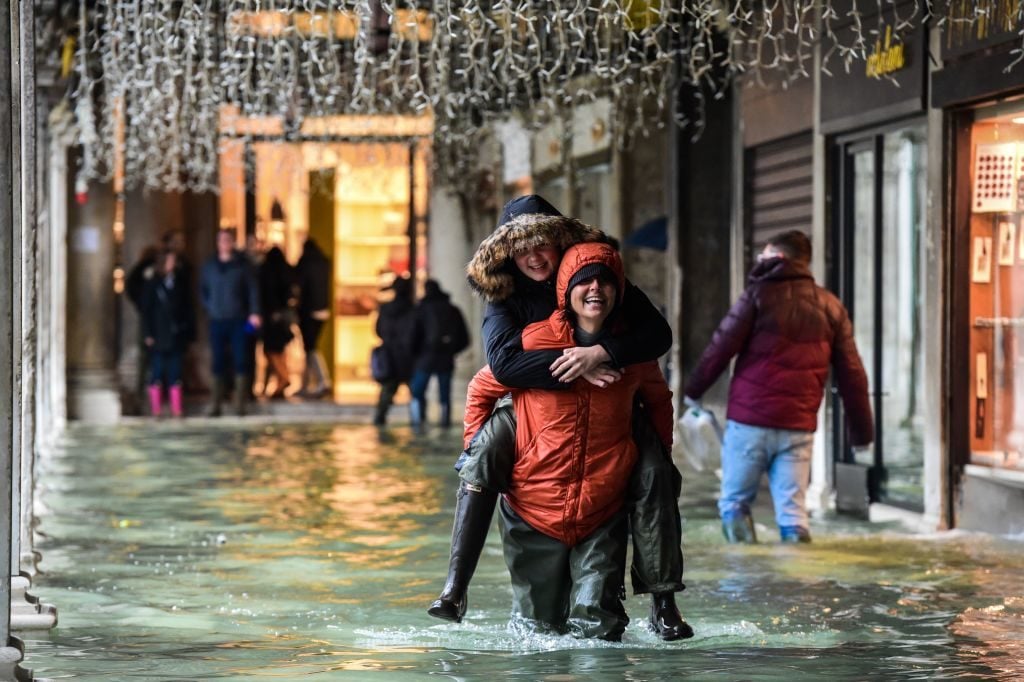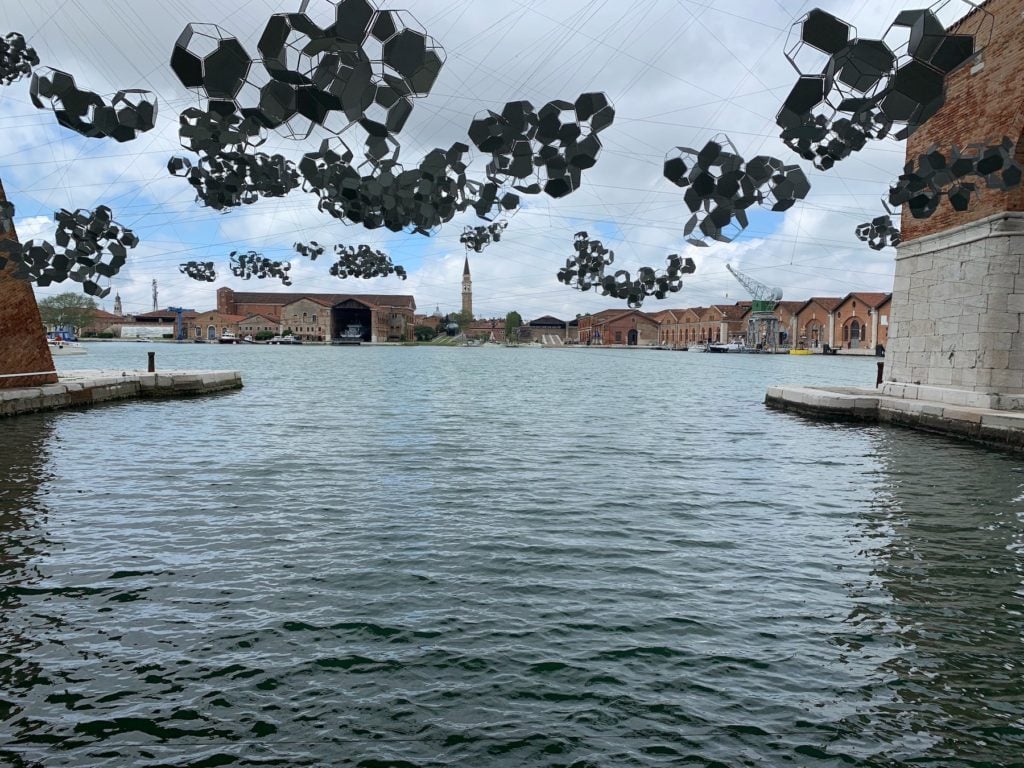Analysis
In the Wake of Devastating Floods, It’s High Time for the Art World to Rethink Its Cherished Relationship to Venice
The curator of the next Venice Biennale should be named any week now. That person is going to have a lot to think about.

The curator of the next Venice Biennale should be named any week now. That person is going to have a lot to think about.

Kate Brown

As the Venice Biennale drew to a close last month, art handlers and gallery assistants sloshed around in knee-high boots. This year, stormy weather and the seasonal high tide, known as “acqua alta,” combined to cause devastating flooding. Venice’s mayor did not mince words, tweeting that the high waters were an effect of climate change.
People woke up on November 24 to find around 80 percent of the city affected with damages estimated at more than $1 billion. A month on, the flood water has subsided, but the troubles for Venice remain. A new question emerges as to whether the city’s many biennials are sustainable, given the risks that even short-haul flights pose to the planet in general, and the fragile ecology of the historic city in particular.
The artistic director of the 2021 Venice Biennale should be named any week now. The recently closed edition attracted more than 600,000 visitors to Venice, a fraction of the city’s more than 25 million annual tourists, but a significant number nevertheless. More than ever the climate emergency will be lapping at the door of the next curator of this most prestigious exhibition. In the wake of devastating floods, will a Biennale-as-usual approach suffice in 2021? Or should the party be scaled back?

A stranded waterbus after being washed away by an exceptionally high tide, November 13, 2019 in Venice. Photo by Marco Bertorello AFP via Getty Images.
One of the defining images of last month’s flood was a stranded water bus displaying advertising for the biennial. The exhibition and its popularity seemed implicated in the city’s plight.
Today, We believe more than ever, that there is an urgent need to strongly support and protect the city of Venice, which is extremely delicate and beloved by so many,” says Karole P. B. Vail, director of the Peggy Guggenheim Collection in Venice. The institution’s ticket office and museum shop suffered damage, which she says was much less severe than some other museums.
“The situation is clearly catastrophic,” says Markus Reymann, the director of TBA21–Academy. Earlier this year, the foundation, which has an ongoing mission to address sea advocacy through art, launched Ocean Space in the Church of San Lorenzo in Venice with a topical, ocean-themed show by Joan Jonas.
Reymann says the imagery of the art world and other tourists splashing around in acqua alta is not entirely bad in the sense that it has a catalyzing effect: “[They] have the potential to become iconic of the arrival of climate change to Europe. For a long time, we have all been very comfortable with the idea of climate change happening elsewhere despite our warm and cold weather extremes in Europe.”
In late November, Ocean Space narrowly escaped flood damage, unlike St Mark’s basilica, among other historic monuments, given that San Lorenzo’s front door is nearly eight feet above sea level. But the flood water reached its very last step, Reymann tells Artnet News. So, when the tide finally flows through its tall front door, it means Venice is in the deepest of troubles.
“As a group of cultural producers, we need to rethink our practice of production, presentation,” Reymann says, though he stresses that we still need exhibitions about the impact of the climate emergency. “What does a rising temperature of 1.5 degrees really mean? What does it mean that 500 million people will have to migrate? Art and artists have a unique capacity to condense these topics in an appealing or disturbing way that lets us build a relationship to that data.”
And in the lead up to the next Biennale, Reymann wonders if everyone (who’s anyone) really needs go. “I think we should think about new formats. Does everybody need to be represented there? Does everyone in the international art world really need to come?”

Fun in a flooded Venetian arcade on November 24, 2019. (Photo by Miguel MEDINA / AFP) (Photo by MIGUEL MEDINA/AFP via Getty Images)
Short-term thinking in general seems to plague the endless circuit of arts and cultural events that take place in Venice. The film festival rolled out the red carpet this fall overlapping with the close of “May You Live In Interesting Times.” Next year the architecture Biennale returns. The Biennale di Venezia, the official body that oversees the city’s exhibitions and festival, did not respond to requests for comment on how it would consider sustainability in future editions.
“It’s difficult to make big infrastructural changes quickly, so I think the question is where to start, as well as what to aim for in the mid-to-long term.” says Lucia Pietroiusti, who curated the award-winning Lithuanian Pavilion that eloquently spoke to the climate emergency. The Serpentine curator says that sharing resources, materials, and knowledge will be essential going forward. That means greater co-operation “between pavilions, as well as with partners and organizations that already work in the territory.”
In the last Biennale’s main exhibition organized by Ralph Rugoff, the Berlin-based artist Tomás Saraceno created a prophetic installation in the Arsenale. Aero(s)cene: when breath becomes air, when atmospheres become the movement for a post fossil fuel era against carbon-capitalist clouds (2019) created a soundscape that related to changing tides and sea levels. Works like this will continue to be important, but the Biennale may also need to rethink its very structure and scale.

Tomás Saraceno, Aero(s)scene: When breath becomes air, when atmospheres become the movement for a post fossil fuel era against carbon-capitalist clouds (2019). Image courtesy Julia Halperin.
Consciousness raising, however poignant, can co-opt the narrative and distract from the bigger issues that need to be urgently addressed in Vence itself. “Obviously there are no quick fixes or one-size-fits-all solutions to problems or questions regarding the climate emergency,” local ecological activist group We Are Venice tells Artnet News. “It would be nice to see an organization as large as the Biennale using its position to determine more stringent life cycle analysis criteria to the use of materials, let alone transportation of art and installations, and installation techniques.”
Pietroiusti and the Lithuanian Pavilion’s assistant curator, Caterina Avataneo, are working on a project for the next Biennale. Pietroiusti describes it as “an independent communications platform where national pavilions can share materials as well as learnings.” Pietroiusti says: “It will be simple, but hopefully useful.”
Ocean Space will keep the reality of the aqua alta at the front of its program. Next year, it will host a large research project by Territorial Agency, an architectural collective that will create a major installation beginning in March 2020. The three-year project will consider Venice’s position as a frontline for the European climate crisis and look at how humans are transforming the oceans.
Artists in the next Biennale will surely continue to tackle this issue with incisiveness as they did in Rugoff’s edition. But less poetic statements, like what to do about resource distribution, carbon-offsetting travel, and waste minimization should be forefront issues for whoever takes the seat.
“[The flooding] is an immense reality check, but also a huge opportunity to rethink what Venice could and should be: maybe not a museum of the past but a laboratory for the future,” says Markus Reymann, the director of TBA21–Academy. “Venice can be a productive place where we can think through how to live with catastrophe, and how to deal with the climate in these frontline locations. How do we live with this emergency? How do we live through it?”
Recently, Bloomberg outlined simple methods to provide aid to the city, proposing a sort of climate-cultural patronage that might appeal to some elite arts supporters. Funding a conservator, for example, costs around $500 a day, while improved flood barriers for buildings cost around $2,200 a piece. The desalination of flooded historic buildings like the Ca’ d’Oro mansion, which would be nursed it back to reasonable health, takes around $69,000. Visitors to the 2021 Biennale could consider off-setting their carbon footprints, as could pavilions, artists, and galleries. Perhaps this is what new arts patronage should look like: a total overhaul of what is valued.
But will any of that get you a seat at the Venice’s art party dinner tables come 2021? Probably not, but as we are witnessing, a lot can change in a few years. The party in Venice needs to be scaled back, because this could be the last song.